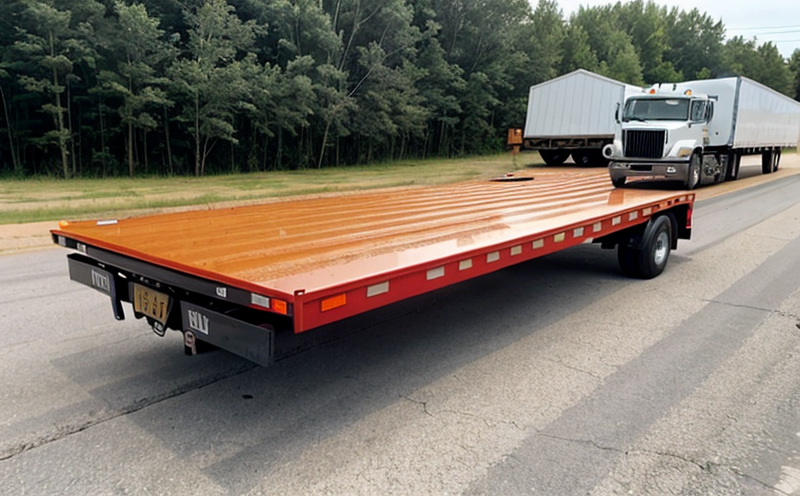Flatbed truck load inspection
The inspection of flatbed truck loads is a critical process in ensuring compliance with regulations and standards that govern transportation. This service involves thorough examination to verify that cargo is securely loaded, properly secured, and adheres to weight limits as per international standards such as ISO 21462-3:2019 and ASTM D7528.
The process begins with a detailed review of the load plan provided by the carrier or shipper. This includes checking the dimensions, weight, and type of cargo to ensure it fits within the flatbed's capabilities without exceeding legal limits. Once this information is verified, the inspection team proceeds to examine the physical condition of the load.
Instrumentation plays a vital role in ensuring accuracy during inspections. High-resolution cameras are used for visual assessments, while load cells and pressure sensors monitor the weight distribution across the flatbed. Additionally, specialized devices like inclinometers measure any potential slippage or shifting issues that could compromise cargo safety.
The inspection team also evaluates the securing mechanisms employed—whether they involve straps, chains, or other restraint systems—to ensure they meet specified standards for strength and integrity. Compliance with EN 12663-4:2015 is crucial here.
Achieving accurate results requires meticulous preparation of the load prior to inspection. Proper labeling, marking, and documentation are essential steps that help in tracking and verifying the condition of each item during transit. For instance, hazardous materials must be clearly marked with appropriate signage as per IMDG Code.
The outcome of these inspections is documented comprehensively using detailed reports which include photos, measurements, and descriptions of any discrepancies found. These reports serve not only as evidence but also as valuable tools for improving future transport operations by identifying areas where improvements can be made.
In summary, flatbed truck load inspection ensures that every aspect of cargo preparation meets stringent requirements set forth by various international bodies. It is essential in maintaining high standards of safety and efficiency throughout the supply chain.
Why It Matters
Properly inspecting flatbed truck loads goes beyond just meeting regulatory requirements; it significantly impacts operational efficiency, cargo integrity, and overall safety. By adhering to strict inspection protocols, carriers can avoid costly delays caused by improper loading or securing practices.
- Maintains Compliance: Ensures that all aspects of the load comply with relevant regulations and standards.
- Reduces Risks: Identifies potential hazards early on, preventing accidents during transit.
- Promotes Efficiency: Streamlines processes by ensuring loads are correctly prepared before transport begins.
- Enhances Reputation: Demonstrates commitment to quality and reliability, enhancing customer trust.
The importance of this service cannot be overstated in today's globalized economy where timely delivery is paramount. A well-executed inspection process helps maintain the integrity of goods while safeguarding against liability concerns that could arise from improper loading or securing methods.
Industry Applications
| Industry Sector | Application |
|---|---|
| LSCM | Evaluating the security of large machinery or construction equipment being transported over long distances. |
| ADD | Checking the stability of sensitive components during air shipments to ensure they arrive intact at their destination. |
| AM | Verifying that finished vehicles are properly secured before being loaded onto transport vehicles for distribution. |
| PB | Ensuring that temperature-sensitive pharmaceutical products remain within specified ranges during transit. |
These inspections are particularly important in sectors where precision is key, such as aerospace or automotive manufacturing. They also play a critical role in logistics and supply chain management by ensuring reliable delivery times across diverse environments.
Environmental and Sustainability Contributions
- Reduction of Fuel Consumption: Properly secured loads minimize the risk of shifting, which can lead to inefficient driving habits that increase fuel consumption.
- Mitigation of Accidents: Secure cargo prevents accidents caused by uneven weight distribution or loose items that may hit other vehicles during transit.
- Minimized Damage: Carefully prepared loads reduce the likelihood of damage occurring to either the cargo itself or surrounding objects.
- Eco-friendly Practices: By enhancing operational efficiency, fewer resources are wasted, contributing positively towards sustainability goals.
Incorporating such practices into routine operations contributes significantly to environmental conservation efforts. It helps reduce waste and promotes more sustainable business practices within the transportation sector.





